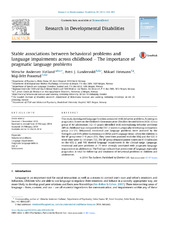Stable associations between behavioral problems and language impairments across childhood – The importance of pragmatic language problems
Peer reviewed, Journal article
Published version
Date
2014-03-15Metadata
Show full item recordCollections
Original version
https://doi.org/10.1016/j.ridd.2014.02.016Abstract
This study investigated language function associated with behavior problems, focusing on pragmatics. Scores on the Children's Communication Checklist Second Edition (CCC-2) in a group of 40 adolescents (12–15 years) identified with externalizing behavior problems (BP) in childhood was compared to the CCC-2 scores in a typically developing comparison group (n = 37). Behavioral, emotional and language problems were assessed by the Strengths and Difficulties Questionnaire (SDQ) and 4 language items, when the children in the BP group were 7–9 years (T1). They were then assessed with the SDQ and the CCC-2 when they were 12–15 years (T2). The BP group obtained poorer scores on 9/10 subscales on the CCC-2, and 70% showed language impairments in the clinical range. Language, emotional and peer problems at T1 were strongly correlated with pragmatic language impairments in adolescence. The findings indicate that assessment of language, especially pragmatics, is vital for follow-up and treatment of behavioral problems in children and adolescents.

